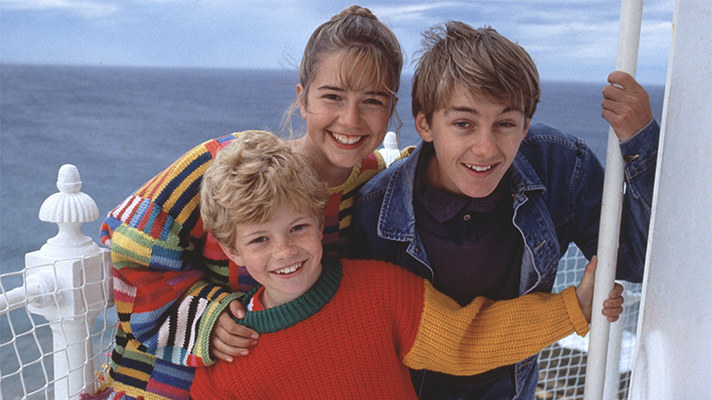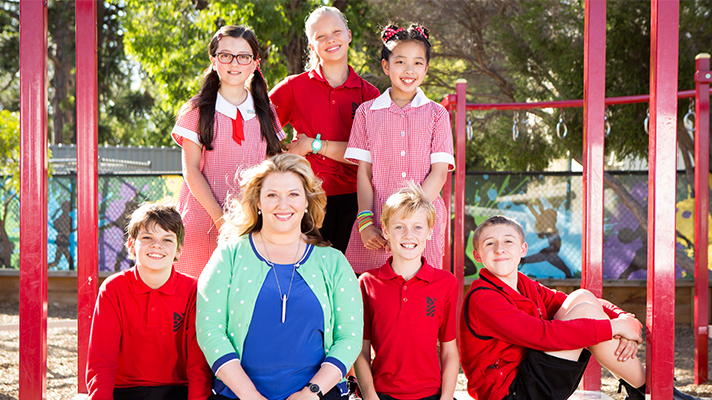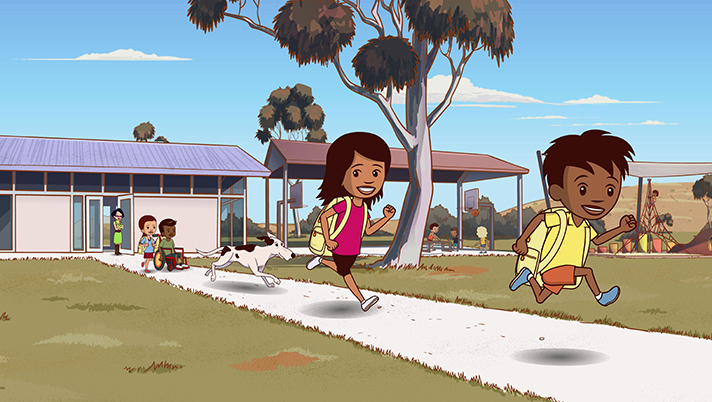Larrikins and Lighthouses: A Time of Change in Australian Children’s Television
Dr Liam Burke, Associate Professor of Screen Studies, and Dr Joanna McIntyre, Senior Lecturer in Media Studies, Swinburne University of Technology
7 Feb 2025
This article was originally published in The Children’s Media Yearbook 2024
In 2024 the Australian High Commissioner to the UK, Stephen Smith, bestowed a special award for cultural impact on the children’s show Bluey. The unprecedented honour recognised the animated series as a global phenomenon, but the success of Bluey belies how technological and legislative changes are creating uncertainty in the Australian children’s television sector. Since 2021, our research project, Australian Children’s Television Cultures (ACTC), has been investigating the roles and value of Australian children’s television. For more than half a century, Australian children’s television has been a cornerstone of Australian culture and vital to explorations and formulations of Australian ‘national identity’. We’ve undertaken this research because Australian children’s television is facing a silent crisis that is too big for one little blue dog to shoulder alone.
When the Australian High Commission bestowed its honour on Bluey, Smith described the show as a ‘fantastic cultural ambassador for Australia’, adding ‘it allows modern day Australian stories to be taken to the world’. For the uninitiated, Bluey is the Emmy award-winning cartoon about a family of anthropomorphized Australian cattle dogs that has become a ratings phenomenon since it first aired on Australia’s main public service broadcaster, the ABC, in 2018. After years working in the UK on children’s shows like Charlie and Lola, Australian animator Joe Brumm created Bluey as an Aussie response to Peppa Pig. Bluey follows the eponymous six-year-old Blue Heeler, her younger sister, Bingo, and their playful parents, Bandit and Chilli, in relatable, but always entertaining, family adventures. Parents, critics, and education experts around the world celebrate this heart-warming series for highlighting the importance of play as well as its humorous tone and ambitious ideas. Bluey is produced by Ludo Studio, based in Brisbane, Queensland. The showis co-funded by the UK’s BBC Studios which also sells the show internationally, including to Disney where it has proven incredibly successful on Disney+ – in the US Bluey was second only to legal drama Suits in 2023 Nielsen streaming viewership.

Although the global reach of Bluey is unprecedented for an Australian children’s television show, Australia has long been recognised as a global provider of quality children’s content. Arguably this proud tradition began with the enduring hit Skippy the Bush Kangaroo in the 1960s. When government support for local productions improved in the 1990s, Australia produced many memorable children’s shows, including the spooky comedy Round the Twist, which national and international audiences enthusiastically embraced. This beloved live-action series features an ‘ordinary’ single-parent family who happen to live in a lighthouse that is frequently the site of supernatural shenanigans. More recent outstanding Australian contributions to the global market include Dance Academy, Little Lunch, and the InBESTigators, which first reached international audiences through broadcast television and, more recently, video-on-demand. Meanwhile, Bananas in Pyjamas and The Wiggles remain perennial pre-school favourites. Although beloved Australian children’s shows cover a wide range of genres and production styles, they tend to have some distinctive characteristics that endear them to audiences. These qualities include unambiguously Australian settings, recognisable family and schoolyard dynamics, and a uniquely Aussie sense of humour that is often described as ‘larrikin’. Considering the proven popularity of these traits, the success of Bluey maybe isn’t such a surprise as it evokes all these endearing elements and now takes them to an even wider audience.
Bluey may be deceptively simple with its unpretentious premise and ‘down to earth’ sensibility but it is, worryingly, a load-bearing pillar of contemporary Aussie children’s television. One of the key aims of our ACTC research project is to help stakeholders like producers, government agencies, and educators navigate the current era of transformation in the television industries. As a country with an enormous landmass but a small population, Australia’s screen industries have survived and thrived because of federal government funding and legislation that protected them. It is with this assistance that Australian children’s television was able to flourish. However, like many overseas equivalents, local Australian children’s content producers have been struggling to navigate the contemporary period of intense technological change in which video-on-demand has fundamentally alerted viewing habits. In 2020, the Australian federal government used the changing television landscape as their rationale for removing longstanding Australian children’s content quotas. For decades these quotas had required commercial broadcasters to produce minimum amounts of Australian children’s television and as such had safeguarded this small but influential sector. Within a few short years of losing these protections, the production and broadcast of Australian children’s content has substantially declined, with the Australian Communications and Media Authority tracking how Australian children’s content on commercial broadcasters dropped by 84% between 2019 and 2022.

The findings and outcomes of our project are designed to inform the Australian children’s television sector as it navigates an era of increased viewing options, policy changes, and new viewing practices. Our findings have been used in many policy submissions and discussion papers by our industry partner, the Australian Children’s Television Foundation (ACTF), on topics ranging from School Refusal to SVOD quotas and a new Prominence Framework for Smart TVs designed to increase the discoverability of local content. As part of this project, we are conducting a four-year programme of audience research with Australian parents and legal guardians of children aged 14 and younger to track and examine the viewing habits of Australian households with young children. We have discovered what Australian families tend to perceive as ‘good’ children’s television, how children use different screen media platforms at home, and what value Australians place on children’s content being ‘local’.
Television industry scholar Anna Potter has examined the role of local children’s content in the state’s “nationing” agenda. Parents also identified this nation-building function with a typical parent comment in our surveys including, “[local children’s TV] leans into our unique heritage without alienating those who have other experiences. Teaching about what it means to be Australian without creating a firm definition”. However, Potter goes on to identify how the production of children’s content in Australia is dependent on overseas funding through co-productions and international sales, which often means that only a small subset of the audience for successful Australian children’s television shows is actually Australian. The perceived tensions between national cultural imperatives and global market forces have only been exacerbated by the dominance of global streaming services who often fund or acquire shows on a worldwide basis. This transnational screen traffic prompts the question: Is there still a need for shows that reflect a local experience? We investigated this issue in our research, asking parents and guardians how important they think it is that children’s television is Australian – a large majority of 83% of respondents deemed it important that the television their children watch is Australian.
Having established there is a consensus that local children’s television is vital to Australian culture, we asked our hundreds of respondents to describe what qualities they think make ‘good’ Australian children’s shows and content. The most common response was these shows were relatable, meaning they feature Australian accents, settings, and iconography, as well as ‘warts-and-all’ portrayals of family life (often contrasted with ‘overly sanitised’ US shows). As one respondent emphasised, ‘Australian children need Australian shows’. Another explained: ‘It’s nice for children to see familiar landmarks and have issues that are current to them, as opposed to Peppa Pig and needing to explain why we don’t have snow at Christmas’.

The ways Aussie children’s television is seen to contribute to ‘nation building’ was revealed to be much more than a prescriptive or neo-colonial project. Notably, our research confirmed the indispensable roles of contemporary children’s shows that prioritise respectful and authentic representations of First Nations people. For Indigenous and non-Indigenous children in Australia, live-action children’s shows Thalu, Red Dirt Riders, and Barrumbi Kids, and animated shows Little J & Big Cuz and Eddie’s Lil’ Homies offer thoughtful and engaging stories about Aboriginal and Torres Strait Islander people and knowledges, which are powerful components to Australian screen culture. Furthermore, Australia is a nation in which 30% of the population was born overseas, and parents who participated in our research celebrated how Australian children’s television can provide a welcoming window into local culture for new Australians. For example, one father-of-two originally from Mexico described how the school-set mockumentary Little Lunch helped him and his children understand how the Australian education system works. For this family, and many others, a local show made school feel more ‘familiar’, offering a sense of comfort and empowerment to both parents and children.
From the lightouse of Round the Twist to the larrikin humour of Bluey, local children’s television is undoubtedly a social glue that connects Australians, communicating Australian identity and values to those within the nation, and to the world. However, with protections for the Australian children’s television sector disappearing and more changes to the television industries still ahead, it remains to be seen where the next Bluey will come from.
Liam Burke and Joanna McIntyre
This article was originally published in The Children’s Media Yearbook 2024
References
Burke, K. (2023) Australian-made children’s TV content found to have collapsed between 2019 and 2022. In: The Guardian, 1 Aug.
Burke, L, McIntyre, J, Balanzategui, J. and Baker, D. (2022). “Parents’ Perspectives on Australian Children’s Television in the Streaming Era.” In: Australian Children’s Television Foundation.
Potter, A. (2021) Globalising the local in children’s television for the post-network era: How Disney+ and BBC Studios helped Bluey the Australian cattle dog jump the national fence. In: International journal of cultural studies, 24(2).
Australian Children’s Television Cultures (ACTC)
Australian Children’s Television Cultures (ACTC) is a research group based at Swinburne University of Technology, Melbourne, Australia. In partnership with the Australian Children’s Television Foundation (ACTF) and RMIT University, ACTC are undertaking a four-year project (2021–2024) to investigate the roles of Australian children’s television and other children’s screen entertainment in people’s lives, memories, families, and education.

Comments
Comments for this post are open.